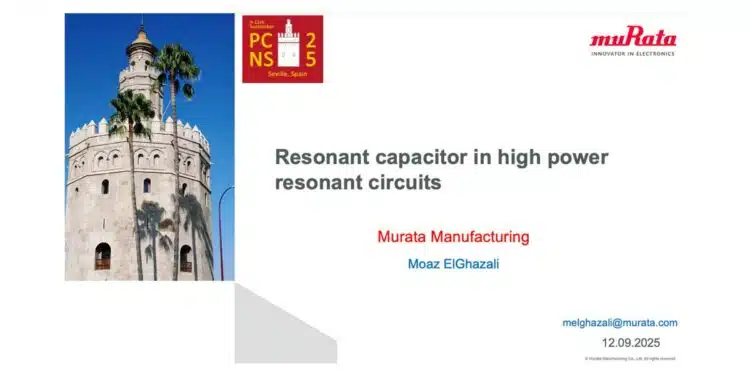The paper “Resonant Capacitors in High-Power Resonant Circuits” was presented by Moaz ElGhazali, Murata Electronics Europe B.V. Germany, Nürnberg, Germany at the 5th PCNS Passive Components Networking Symposium 9-12th September 2025, Seville, Spain as paper No. 5.4.
Introduction
The paper “Resonant Capacitors in High-Power Resonant Circuits” focuses on the increasing use of multilayer ceramic capacitors (MLCCs) in high-power resonant applications such as automotive onboard chargers (OBCs), server power supplies, and large-scale wireless power transfer (WPT) systems.
It emphasizes how MLCCs ceramic capacitors can replace traditional film capacitors due to their compact size, superior high-frequency performance, low loss, and robust long-term reliability.
Murata Electronics introduces its 630 Vdc and 1000 Vdc MLCC product lines, highlighting their advantages and providing engineers with a selection tool, “Simsurfing,” to simplify capacitor choice and configuration.
Key Points
- High adoption of resonant circuits in electric vehicles (EVs), plug-in hybrid vehicles (PHVs), and wireless power transfer systems.
- MLCC advantages over film capacitors include smaller footprint, lower heat generation, and improved thermal and electrical performance.
- Technical requirements focus on high voltage handling, high-frequency capability, low dielectric loss, and long-term reliability.
- Murata MLCC lineup supports both standard and metal-terminal packages, with capacitance values up to 54 nF and operating temperatures from −55 to +125°C.
- Voltage derating and self-heating are critical in selecting and configuring MLCCs to ensure longevity and safe operation.
- Simsurfing selection tool offers automated recommendations for MLCCs and their optimal series–parallel networks.
Extended Summary
Recent developments in electric vehicles and wireless power transfer have driven the adoption of resonant circuits in power conversion systems to over 90%. LLC and LC topologies improve power efficiency, reduce filter requirements, and allow high-frequency operation. These conditions place stringent demands on resonant capacitors, which must sustain high peak-to-peak voltages, tolerate elevated temperatures, and exhibit low dielectric losses.
MLCCs are positioned as a superior alternative to film capacitors for such scenarios. Their compact form factor allows series–parallel network configurations to achieve high voltage ratings without occupying excessive space. In comparison to film capacitors, MLCCs offer three times smaller footprints, lower ESR and ESL, and better self-heating properties, which enhance efficiency in resonant circuits operating from 60 kHz to 400 kHz.
Technical requirements include stable capacitance above 10 nF, low losses under high-frequency excitation, and the ability to maintain surface temperatures below 125°C throughout a 10-year operational life. Murata addresses these needs with standard chip MLCCs and metal-terminal MLCCs. The latter reduces solder-crack risk in automotive environments and supports capacitance up to 54 nF. Both variants rely on C0G dielectric, which ensures exceptional thermal stability (0 ±30 ppm/°C from 25 to 125°C).
Voltage derating is essential to prevent excessive self-heating. The paper categorizes operating frequencies into three ranges, each with specific derating behavior: below 10 kHz where rated voltage governs, 10–100 kHz where continuous thermal rise limits operation, and above 100 kHz where initial heating constrains voltage application. Detailed derating charts guide engineers in applying optimal series–parallel configurations for reliable long-term service.
Murata’s “Simsurfing” web tool significantly eases the selection process by allowing engineers to input frequency, voltage, temperature, and required capacitance. It then suggests suitable MLCC products and network arrangements, ensuring both performance and durability in demanding resonant applications.
Conclusion
MLCCs are highly suitable for modern high-power resonant circuits due to their compact size, low loss, superior thermal properties, and long-term reliability. By following proper series–parallel configurations and adhering to voltage derating guidelines, engineers can confidently replace film capacitors with MLCCs. Murata’s comprehensive MLCC lineup, combined with the “Simsurfing” selection tool, offers a streamlined approach to optimize resonant circuit design and enhance system efficiency.































